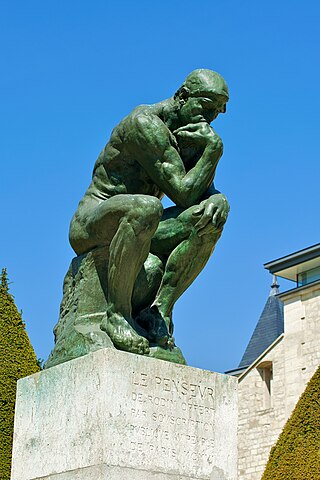Related Research Articles

Cognitive science is the interdisciplinary, scientific study of the mind and its processes. It examines the nature, the tasks, and the functions of cognition. Mental faculties of concern to cognitive scientists include language, perception, memory, attention, reasoning, and emotion; to understand these faculties, cognitive scientists borrow from fields such as linguistics, psychology, artificial intelligence, philosophy, neuroscience, and anthropology. The typical analysis of cognitive science spans many levels of organization, from learning and decision to logic and planning; from neural circuitry to modular brain organization. One of the fundamental concepts of cognitive science is that "thinking can best be understood in terms of representational structures in the mind and computational procedures that operate on those structures."
Situated cognition is a theory that posits that knowing is inseparable from doing by arguing that all knowledge is situated in activity bound to social, cultural and physical contexts.
Distributed cognition is an approach to cognitive science research that was developed by cognitive anthropologist Edwin Hutchins during the 1990s.

David Kirsh is a Canadian cognitive scientist. He is a professor of cognitive science at the University of California, San Diego (UCSD), where he heads the Interactive Cognition Lab. From 2020-2023 he was the President of the Academy of Neuroscience for Architecture (ANFA), where he remains on the Board of Directors.

Stephen Grossberg is a cognitive scientist, theoretical and computational psychologist, neuroscientist, mathematician, biomedical engineer, and neuromorphic technologist. He is the Wang Professor of Cognitive and Neural Systems and a Professor Emeritus of Mathematics & Statistics, Psychological & Brain Sciences, and Biomedical Engineering at Boston University.

Nancy Katherine Hayles is an American postmodern literary critic, most notable for her contribution to the fields of literature and science, electronic literature, and American literature. She is the James B. Duke Distinguished Professor Emerita of Literature, Literature, Trinity College of Arts & Sciences at Duke University.

Lucy Suchman is Professor Emerita of Anthropology of Science and Technology in the Department of Sociology at Lancaster University, in the United Kingdom, also known for her work at Xerox PARC in the 1980s and 90s.
James D. Hollan is professor of cognitive science and adjunct professor of computer science at the University of California, San Diego. In collaboration with Professor Edwin Hutchins, he directs the Distributed Cognition and Human–Computer Interaction Laboratory at UCSD, and co-directs the Design Lab. Hollan has also spent time working at Xerox PARC and at Bellcore. He was elected to the CHI Academy in 2003 and received the ACM SIGCHI Lifetime Research Award in 2015.

Paul Dourish is a computer scientist best known for his work and research at the intersection of computer science and social science. Born in Scotland, he holds the Steckler Endowed Chair of Information and Computer Science at the University of California, Irvine, where he joined the faculty in 2000, and where he directs the Steckler Center for Responsible, Ethical, and Accessible Technology. He is a Fellow of the AAAS, the ACM, and the BCS, and is a two-time winner of the ACM CSCW "Lasting Impact" award, in 2016 and 2021.
Enactivism is a position in cognitive science that argues that cognition arises through a dynamic interaction between an acting organism and its environment. It claims that the environment of an organism is brought about, or enacted, by the active exercise of that organism's sensorimotor processes. "The key point, then, is that the species brings forth and specifies its own domain of problems ...this domain does not exist "out there" in an environment that acts as a landing pad for organisms that somehow drop or parachute into the world. Instead, living beings and their environments stand in relation to each other through mutual specification or codetermination" (p. 198). "Organisms do not passively receive information from their environments, which they then translate into internal representations. Natural cognitive systems...participate in the generation of meaning ...engaging in transformational and not merely informational interactions: they enact a world." These authors suggest that the increasing emphasis upon enactive terminology presages a new era in thinking about cognitive science. How the actions involved in enactivism relate to age-old questions about free will remains a topic of active debate.
Anne Friedberg was an American author, historian and theorist of modern media culture, chair of the Critical Studies Division in the School of Cinematic Arts at the University of Southern California and President-elect of the Society for Cinema and Media Studies.
Machine perception is the capability of a computer system to interpret data in a manner that is similar to the way humans use their senses to relate to the world around them. The basic method that the computers take in and respond to their environment is through the attached hardware. Until recently input was limited to a keyboard, or a mouse, but advances in technology, both in hardware and software, have allowed computers to take in sensory input in a way similar to humans.

Beatriz da Costa was an interdisciplinary artist known for her work at the intersection of contemporary art, science, engineering, and politics. Her projects took the form of public interventions and workshops, conceptual tool building, and critical writing.

Embodied cognition is the concept suggesting that many features of cognition are shaped by the state and capacities of the organism. The cognitive features include a wide spectrum of cognitive functions, such as perception biases, memory recall, comprehension and high-level mental constructs and performance on various cognitive tasks. The bodily aspects involve the motor system, the perceptual system, the bodily interactions with the environment (situatedness), and the assumptions about the world built the functional structure of organism's brain and body.
Ezequiel A Di Paolo is a full-time Research Professor at Ikerbasque, the Basque Foundation for Science. He also has affiliations with the Centre for Computational Neuroscience and Robotics at the University of Sussex. His field of research covers enactivism and embodiment in cognitive science.
Adrianne Wortzel is an American contemporary artist who uses robotics and interaction between humans and machines in her installations and performances. She has also created many online works.

Embodied design grows from the idea of embodied cognition: that the actions of the body can play a role in the development of thought and ideas. Embodied design brings mathematics to life; studying the effects of the body on the mind, researchers learn how to design objects and activities for learning. Embodiment is an aspect of pattern recognition in all fields of human endeavor.
Cognitive biology is an emerging science that regards natural cognition as a biological function. It is based on the theoretical assumption that every organism—whether a single cell or multicellular—is continually engaged in systematic acts of cognition coupled with intentional behaviors, i.e., a sensory-motor coupling. That is to say, if an organism can sense stimuli in its environment and respond accordingly, it is cognitive. Any explanation of how natural cognition may manifest in an organism is constrained by the biological conditions in which its genes survive from one generation to the next. And since by Darwinian theory the species of every organism is evolving from a common root, three further elements of cognitive biology are required: (i) the study of cognition in one species of organism is useful, through contrast and comparison, to the study of another species' cognitive abilities; (ii) it is useful to proceed from organisms with simpler to those with more complex cognitive systems, and (iii) the greater the number and variety of species studied in this regard, the more we understand the nature of cognition.

Nancy Evelyn Paterson (1957–2018) was a Canadian artist and writer known for her work in new media. She was an associate professor at the Ontario College of Art and Design University from 1990 to 2018, and was Facilities Coordinator at Charles Street Video, a non-profit, artist-run centre providing production and post-production facilities for digital video and audio.
Judith S. Olson is an American researcher best known for her work in the field of human-computer interaction and the effect of distance on teamwork.
References
- ↑ University of California, Irvine
- ↑ Newington College Register of Past Students 1863-1998 (Syd, 1999) pp 155
- ↑ Charlie Gere, Art, Time and Technology: Histories of the Disappearing Body (2005) Berg, p. 137
- ↑ "Simon Penny | ISEA2011 Istanbul". Archived from the original on 28 January 2012.
- ↑ "UC Irvine - Faculty Profile System - Simon Penny".
- ↑ Mitchell Whitelaw, "Metacreation. Art and Artificial Life" (2004) MIT Press, p. 124
- ↑ "SIMON PENNY - ADA | Archive of Digital Art".
- ↑ "SIMON PENNY - ADA | Archive of Digital Art".
- ↑ Penny, Simon (2015). "Emergence, Agency and Interaction - notes from the field". doi:10.13140/RG.2.1.5108.7529.
{{cite journal}}: Cite journal requires|journal=(help) - ↑ Stephen Wilson, Information Arts (2002) MIT Press, p. 345
- ↑ "Faculty | Department of Art | Claire Trevor School of the Arts".
- ↑ "Simon Penny (biography)".
- ↑ "The Flock – Ken Rinaldo".
- ↑ "Digital Arts and Culture 2009".
- ↑ "Simon Penny – Leonardo Electronic Almanac". 2 April 2012.
- ↑ "SimonPenny.net".
- ↑ "SimonPenny.net".
- ↑ "Body Electric: An Exhibit by Professor Simon Penny | the Henry Samueli School of Engineering at UC Irvine".
- ↑ "Fugitive II". Archived from the original on 19 September 2006.
- ↑ "Bill Vorn Bedlam".
- ↑ "SimonPenny.net".
- ↑ "SimonPenny.net".
- ↑ "SimonPenny.net".
- ↑ "SimonPenny.net".
- ↑ "SimonPenny.net".
- ↑ "SimonPenny.net".